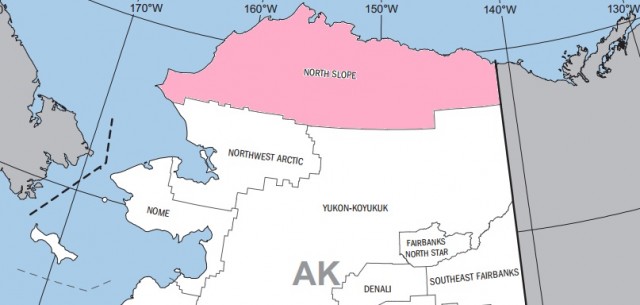North Slope
THE NORTH SLOPE of ALASKA stretches from the high mountains of the Brooks Range to the ARCTIC OCEAN on the north. Miles of barren coastal plains and low, rolling hills, caused by freezing and thawing of the ground, make up the region. No trees are in evidence, as the short growing season will support only tundra plants. The word tundra comes from the Finnish word tunturia, meaning treeless plain. Tundra is characterized by extremely cold climate, limited drainage, a short growing season, and few plants and animals. Soil forms slowly and there is a layer of permanently frozen subsoil called permafrost. There is very little daylight in winter and temperatures are bitterly cold. In Barrow, the northernmost city on the North Slope, the winter temperatures can get down to -50 degrees F (-46 degrees C). Summer temperatures in Barrow average 40 degrees F (4.5 degrees C). Some parts of the North Slope are a bit warmer, but the whole area has a chilly arctic climate.

The North Slope receives only about 5 to 15 in (12.5 to 37.5 cm) of precipitation a year. During warmer weather, water stands on the surface, causing numerous small lakes. Wide shallow rivers flow north to the ocean. Sedges, reindeer mosses, low shrubs and grasses grow on the tundra, as well as 400 varieties of flowers. The plants must adapt to strong winds, low temperatures, and poor soil. Herds of caribou roam the area in summer. Other animals that live on the North Slope at some time of year include wolves, foxes, polar bears, seals, whales, and small mammals such as lemmings, voles, and ground squirrels.
The entire North Slope, which encompasses over 89,000 square mi (230,509 square km), is organized into one borough, making it the largest municipality in the world. The region is about the size of the state of MINNESOTA and lies entirely above the ARCTIC CIRCLE. Many of the people live a subsistence lifestyle and depend on hunting, trapping and whaling for much of their food.
There is no commercial agriculture within the North Slope, because of the short cool growing season and poor soil. Some people have gardens for their own use. The growing season has very long hours of sunlight, but produce has to be limited to plants that will grow and mature in temperatures ranging from 50 to 60 degrees F (10 to 16 degrees C). Besides Barrow, the North Slope includes the villages of Anaktuvuk Pass, Atqasuk, Kaktovik, Nuiqsut, Point Hope, Point Lay, and Wainwright. Most of the people who live here are Inuit. They used to be known as Eskimos, but prefer the term Inuit, which means “the People.”
Petroleum was discovered at Prudhoe Bay in 1968. An 800-mi (1,287-km) pipeline was built and began carrying oil south to the port of Valdez in 1977. There is still controversy over whether or not oil drilling should be allowed in the ARCTIC NATIONAL WILDLIFE REFUGE in the far northeast part of the North Slope. The refuge includes 10,039 square mi (76,000 square km) of land. Research shows that lasting environmental damage has resulted from oil drilling at Prudhoe Bay.